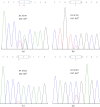Mixed Infections and Rifampin Heteroresistance among Mycobacterium tuberculosis Clinical Isolates
- PMID: 25903578
- PMCID: PMC4473183
- DOI: 10.1128/JCM.03507-14
Mixed Infections and Rifampin Heteroresistance among Mycobacterium tuberculosis Clinical Isolates
Abstract
Mixed infections and heteroresistance of Mycobacterium tuberculosis contribute to the difficulty of diagnosis, treatment, and control of tuberculosis. However, there is still no proper solution for these issues. This study aimed to investigate the potential relationship between mixed infections and heteroresistance and to determine the high-risk groups related to these factors. A total of 499 resistant and susceptible isolates were subjected to spoligotyping and 24-locus variable-number tandem repeat methods to analyze their genotypic lineages and the occurrence of mixed infections. Two hundred ninety-two randomly selected isolates were sequenced on their rpoB gene to examine mutations and heteroresistance. The results showed that 12 patients had mixed infections, and the corresponding isolates belonged to Manu2 (n = 8), Beijing (n = 2), T (n = 1), and unknown (n = 1) lineages. Manu2 was found to be significantly associated with mixed infections (odds ratio, 47.72; confidence interval, 9.68 to 235.23; P < 0.01). Four isolates (1.37%) were confirmed to be heteroresistant, which was caused by mixed infections in three (75%) isolates; these belonged to Manu2. Additionally, 3.8% of the rifampin-resistant isolates showing no mutation in the rpoB gene were significantly associated with mixed infections (χ(2), 56.78; P < 0.01). This study revealed for the first time that Manu2 was the predominant group in the cases of mixed infections, and this might be the main reason for heteroresistance and a possible mechanism for isolates without any mutation in the rpoB gene to become rifampin resistant. Further studies should focus on this lineage to clarify its relevance to mixed infections.
Copyright © 2015, American Society for Microbiology. All Rights Reserved.
Figures

References
-
- Mankiewicz E, Liivak M. 1975. Phage types of mycobacterium tuberculosis in cultures isolated from Eskimo patients. Am Rev Respir Dis 111:307–312. - PubMed
-
- van Rie A, Victor TC, Richardson M, Johnson R, van der Spuy GD, Murray EJ, Beyers N, Gey van Pittius NC, van Helden PD, Warren RM. 2005. Reinfection and mixed infection cause changing Mycobacterium tuberculosis drug-resistance patterns. Am J Respir Crit Care Med 172:636–642. doi:10.1164/rccm.200503-449OC. - DOI - PMC - PubMed
-
- Zetola NM, Shin SS, Tumedi KA, Moeti K, Ncube R, Nicol M, Collman RG, Klausner JD, Modongo C. 2014. Mixed Mycobacterium tuberculosis complex infections and false-negative results for rifampin resistance by GeneXpert MTB/RIF are associated with poor clinical outcomes. J Clin Microbiol 52:2422–2429. doi:10.1128/JCM.02489-13. - DOI - PMC - PubMed
Publication types
MeSH terms
Substances
LinkOut - more resources
Full Text Sources
Medical

